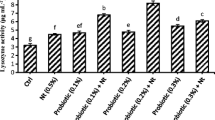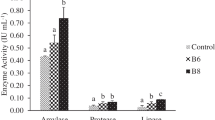Abstract
In this study, we have investigated the effect of probiotic Lactobacillus helveticus CD6 supplemented into simple laboratory fish feed (LFF) and complex, multi-ingredient market fish feed (MFF) on growth performance, antioxidant levels, and essential trace element absorption in goldfish (Carassius auratus). Twenty-four healthy goldfish (average weight 3–4 g) were acclimatized and divided into four experimental diets supplemented with 3 × 107 CFU/g of probiotic (LFF + Pro, MFF + Pro) and without probiotic (LFF, MFF) for 14 weeks. Fish fed with probiotic were healthy, active, and intense orange-gold as compared to control (without probiotic). At 14 weeks, fish fed with MFF + Pro/LFF + Pro showed 91/47% weight gain as compared to 34/− 12% weight observed with MFF/LFF. The average weight gain differences recorded between probiotic and control diets were not significant. No mortality to report when fish fed with probiotic. In contrast, fish fed without probiotic showed mortalities (LFF, two fish; MFF, one fish) during the trial. DPPH activity revealed high levels of antioxidants into the intestine of probiotic-fed fish. Trace element analysis showed that probiotic colonization enhanced diet-dependent absorption of Fe and Zn. The in vitro antimicrobial activity was exhibited by probiotic L. helveticus CD6 against infected fish isolate Aeromonas spp. JA showed an ability to protect fish from infections. Moreover, complex, multi-ingredient feed had a highest impact on viability of probiotic during storage. In conclusion, L. helveticus CD6 did not significantly enhance growth performance; however, it improved health and reduced mortalities in goldfish (C. auratus) regardless of the composition of the diet.






Similar content being viewed by others
References
Ladisa C, Bruni M, Lovatelli A (2017) Overview of ornamental species aquaculture. FAO Aquaculture Newsletter 56:38–39
Stevens CH, Croft DP, Paull GC, Tyler CR (2017) Stress and welfare in ornamental fishes: what can be learned from aquaculture? J Fish Biol 91:409–428
Lewbart GA (2001) Bacteria and ornamental fish. Semin Avian Exotic Pet Med 10:48–56
Ota KG, Abe G (2016) Goldfish morphology as a model for evolutionary developmental biology. Wiley Interdiscip Rev Dev Biol 5:272–295
Abe G, Lee SH, Li J, Chang CJ, Tamura K, Ota KG (2016) Open and closed evolutionary paths for drastic morphological changes, involving serial gene duplication, sub-functionalization, and selection. Sci Rep 6:srep26838
Abe G, Ota KG (2016) Evolutionary developmental transition from median to paired morphology of vertebrate fins: perspectives from twin-tail goldfish. Dev Biol 427:251–257
Imanpoor MR, Najafi E, Kabir M (2012) Effect of different salinity and temperatures on the growth, survival, haematocrit and blood biochemistry of goldfish (Carassius auratus). Aquaculture Res 43:332–338
Shimizu M, Takase Y, Kouno K (1976) Fish disease treatment. US Patent 3981999
Schmidt V, Gomez-Chiarri M, Roy C, Smith K, Amaral-Zettler L (2017) Subtle microbiome manipulation using probiotics reduces antibiotic-associated mortality in fish. mSystems 2:e00133–17
Patil HJ, Benet-Perelberg A, Naor A, Smirnov M, Ofek T, Nasser A, Minz D, Cytryn E (2016) Evidence of increased antibiotic resistance in phylogenetically-diverse Aeromonas isolates from semi-intensive fish ponds treated with antibiotics. Front Microbiol 7:1875
FAO/WHO (2002) Guidelines for the evaluation of probiotics in food, report of a joint FAO/WHO working group on drafting guidelines for the evaluation of probiotics in food, London, Ontario, Canada, pp 1–11
Fečkaninová A, Koščová J, Mudroňová D, Popelka P, Toropilová J (2017) The use of probiotic bacteria against Aeromonas infections in salmonid aquaculture. Aquaculture 469:1–8
Nayak SK (2010) Probiotics and immunity: a fish perspective. Fish Shellfish Immunol 29:2–14
Zorriehzahra MJ, Delshad ST, Adel M, Tiwari R, Karthik K, Dhama K, Lazado CC (2016) Probiotics as beneficial microbes in aquaculture: an update on their multiple modes of action: a review. Vet Quart 36:228–241
Mehdinejad N, Imanpour MR, Jafari V (2017) Combined or individual effects of dietary probiotic Pedicoccus acidilactici and nucleotide on growth performance, intestinal microbiota, hemato-biochemical parameters, and innate immune response in goldfish (Carassius auratus). Probiotics & Antimicro Prot. https://doi.org/10.1007/s12602-017-9297-31-8
Anuar NS, Omar NS, Noordiyana MN, Sharifah NE (2017) Effect of commercial probiotics on the survival and growth performance of goldfish Carassius auratus. AACL Bioflux 10:1663–1670
Subharanjani S, Gunarani R, Prema P, Immanuel G (2015) Potential influence of probiotic bacteria on the growth gut microflora of Carassius auratus. Int J Fish Aquat Stud 2:319–323
Abraham TJ, Mondal S, Babu CS (2008) Effect of commercial aquaculture probiotic and fish gut antagonistic bacterial flora on the growth and disease resistance of ornamental fishes Carassius auratus and Xiphophorus helleri. J Fish Aquat Sci 25:27–30
Sinha A, Ghosh S, Singh D (2004) Probiotics as nutrient supplement in artificial feed of gold fish (Carassius auratus). J Indian Fish Assoc 31:139–144
Ahire JJ (2012) Studies on probiotic microorganism(s) and its biogenic metabolite(s). Ph.D. Dissertation, North Maharashtra University, India
Ahire JJ, Mokashe NU, Patil HJ, Chaudhari BL (2013) Antioxidative potential of folate producing probiotic Lactobacillus helveticus CD6. J Food Sci Tech 50:26–34
Ahire JJ, Bhat AA, Thakare JM, Pawar PB, Zope DG, Jain RM, Chaudhari BL (2012) Cholesterol assimilation and biotransformation by Lactobacillus helveticus. Biotechnol Lett 34:103–107
Ahire JJ, Mokashe NU, Chaudhari BL (2014) Cholesterol biotransformation to cholesta-4,6-die-3-ol and effect of assimilation on adhesion properties of Lactobacillus helveticus CD6. J Microbiol Biotech Food Sci 3:398–401
Paradeshi JS, Patil SN, Koli SH, Chaudhari BL (2017) Effect of copper on probiotic properties of Lactobacillus helveticus CD6. Int J Dairy Technol 71:204–212. https://doi.org/10.1111/1471-0307.12384
Kestemont P (1995) Influence of feed supply, temperature and body size on the growth of goldfish Carassius auratus larvae. Aquaculture 136:341–349
Smith SB, Donahue AP, Lipkin R, Blazer VS, Schmitt CJ (2002) Illustrated field guide for assessing external and internal anomalies in fish. US geological survey information and technology Reports 2002–2007:46
Ahilan B, Shine G, Santhanam R (2004) Influence of probiotics on the growth and gut microbial load of juvenile goldfish (Carassius auratus). Asian Fish Sci 17:271–278
Shotts EB Jr, Rimler R (1973) Medium for isolation of Aeromonas hydrophila. Appl Microbiol 26:550–553
Ahire JJ, Patil KP, Chaudhari BL, Chincholkar SB (2011) Bacillus spp. of human origin: a potential siderophoregenic probiotic bacteria. Appl Biochem Biotechnol 164:386−400
Yadav SB, Athol VK, Peter JD, Wayne LB (2016) FAO: probiotics in animal nutrition—production, impact and regulation. In: Makkar HPS (ed) FAO animal production and health paper. 179
Reddy MS (1989) Shelf life and subsequent growth of Lactobacillus acidophilus, Propionibacterium shermanii and Leuconostoc citrovorum in dietary fiber based supplement preparation. US Patent 4806368
Nag A, Das S (2013) Improving ambient temperature stability of probiotics with stress adaptation and fluidized bed drying. J Funct Foods 5:170−177
Gardiner GE, O’sullivan E, Kelly J, Auty MAE, Fitzgerald GF, Collins JK, Ross RP, Stanton C (2000) Comparative survival rates of human-derived probiotic Lactobacillus paracasei and L. salivarius strains during heat treatment and spray drying. Appl Environ Microbiol 66:2605−2612
Tripathi MK, Giri SK (2014) Probiotic functional foods: survival of probiotics during processing and storage. J Funct Foods 9:225–241
Rawls JF, Mahowald MA, Ley RE, Gordon JI (2006) Reciprocal gut microbiota transplants from zebrafish and mice to germ-free recipients reveal host habitat selection. Cell 127:423–433
Salminen S, Ouwehand A, Benno Y, Lee YK (1999) Probiotics: how should they be defined? Trends Food Sci Technol 10:107–110
Gismondo MR, Drago L, Lombardi A (1999) Review of probiotics available to modify gastrointestinal flora. Int J Antimicrob Agents 12:287–292
Cruz PM, Ibáñez AL, Hermosillo OAM, Saad HCR (2012) Use of probiotics in aquaculture. ISRN Microbiol 916845
El-Haroun ER, Goda AS, Chowdhury K (2006) Effect of dietary probiotic Biogen® supplementation as a growth promoter on growth performance and feed utilization of Nile tilapia Oreochromis niloticus (L.). Aquac Res 37:1473–1480
Austin B, Adams C (1996) Fish pathogens. In Austin B, Altwegg M, Gosling PJ, Joseph S (ed) The genus Aeromonas, John Wiley & Sons, England, pp 197–243
Janda JM, Abbott SL (2010) The genus Aeromonas: taxonomy, pathogenicity, and infection. Clin Microbiol Rev 23:35–73
Thenmozhi N, Ahilan B (2014) Influence of health promoting additives on the growth, gonad development and disease resistance of goldfish. J Aqua Trop 29:145–154
Balmus IM, Ciobica A, Trifan A, Stanciu C (2016) The implications of oxidative stress and antioxidant therapies in inflammatory bowel disease: clinical aspects and animal models. Saudi J Gastroenterol 22:3–17
Nandi A, Banerjee G, Dan SK, Ghosh K, Ray AK (2017) Evaluation of in vivo probiotic efficiency of Bacillus amyloliquefaciens in Labeo rohita challenged by pathogenic strain of Aeromonas hydrophila MTCC 1739. Probiotics Antimicro Prot. https://doi.org/10.1007/s12602-017-9310-x
Rajkowska M, Protasowicki M (2013) Distribution of metals (Fe, Mn, Zn, Cu) in fish tissues in two lakes of different trophy in Northwestern Poland. Environ Monit Assess 185:3493–3502
Watanabe T, Kiron V, Satoh S (1997) Trace minerals in fish nutrition. Aquaculture 151:185–207
Acknowledgements
Patil DK is gratefully acknowledged for his assistance during the study.
Funding
Ahire JJ received a financial support from UGC-RFSMS (Grant No.: F.4-1/2006 (BSR)/7-137/2007(BSR)), New Delhi, during Ph.D. (2010–2012) at North Maharashtra University, Jalgaon, India.
Author information
Authors and Affiliations
Corresponding author
Ethics declarations
All institutional and national guidelines for the care and use of laboratory animals were followed.
Conflict of Interest
The authors declare that they have no conflict of interest.
Rights and permissions
About this article
Cite this article
Ahire, J.J., Mokashe, N.U. & Chaudhari, B.L. Effect of Dietary Probiotic Lactobacillus helveticus on Growth Performance, Antioxidant Levels, and Absorption of Essential Trace Elements in Goldfish (Carassius auratus). Probiotics & Antimicro. Prot. 11, 559–568 (2019). https://doi.org/10.1007/s12602-018-9428-5
Published:
Issue Date:
DOI: https://doi.org/10.1007/s12602-018-9428-5




